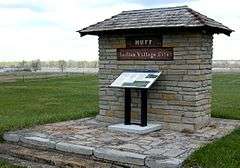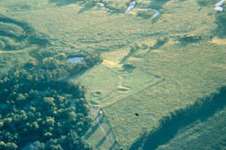List of National Historic Landmarks in North Dakota
North Dakota National Historic Landmarks (clickable map)
The List of National Historic Landmarks in North Dakota contains the landmarks designated by the U.S. Federal Government for the U.S. state of North Dakota.
There are 6 National Historic Landmarks (NHLs) in North Dakota.
Current National Historic Landmarks
| [1] |
Landmark name |
Image |
Date designated[2] |
Location |
County |
Description |
|---|
| 1 |
Frederick A. and Sophia Bagg Bonanza Farm |
|
000000002005-04-05-0000April 5, 2005
(#85002832) |
Mooreton
46°15′11″N 96°51′57″W / 46.253056°N 96.865833°W / 46.253056; -96.865833 (Frederick A. and Sophia Bagg Bonanza Farm) |
Richland |
Preserved bonanza farm.
|
| 2 |
Big Hidatsa Village Site |
|
000000001964-07-19-0000July 19, 1964
(#66000600) |
Stanton
47°21′41″N 101°23′22″W / 47.361255°N 101.389541°W / 47.361255; -101.389541 (Big Hidatsa Village Site) |
Mercer |
Largest of three villages preserved in Knife River Indian Villages National Historic Site.
|
| 3 |
Fort Union Trading Post |
|
000000001961-07-04-0000July 4, 1961
(#66000103) |
Williston vicinity
47°59′58″N 104°02′26″W / 47.999444°N 104.040556°W / 47.999444; -104.040556 (Fort Union Trading Post) |
McKenzie and Williams |
Most important fur trading post on the upper Missouri until 1867. Visitors included John James Audubon, George Catlin, Father Pierre DeSmet, Sitting Bull, Karl Bodmer, and Jim Bridger.
|
| 4 |
Huff Archeological Site |
|
000000001997-02-18-0000February 18, 1997
(#80002920) |
Huff
46°37′07″N 100°38′33″W / 46.618611°N 100.6425°W / 46.618611; -100.6425 (Huff Archeological Site) |
Morton |
Former fortified village of the Mandan, on the bank of Lake Oahe. Archaeological site, now a state park open to the public.
|
| 5 |
Lynch Knife River Flint Quarry |
|
000000002011-07-13-0000July 13, 2011
(#11000629) |
near Dunn Center
47°21′12″N 102°37′22″W / 47.353333°N 102.622778°W / 47.353333; -102.622778 (Lynch Knife River Flint Quarry) |
Dunn |
|
| 6 |
Menoken Indian Village Site |
|
000000001964-07-19-0000July 19, 1964
(#66000599) |
Bismarck
46°50′29″N 100°31′06″W / 46.841495°N 100.518386°W / 46.841495; -100.518386 (Menoken Indian Village Site) |
Burleigh |
Site of village in 1200s CE, now a state park. |
See also
References
|
|---|
|
| Topics | |
|---|
|
| Lists by states | |
|---|
|
| Lists by insular areas | |
|---|
|
| Lists by associated states | |
|---|
|
| Other areas | |
|---|
|
-
 Portal Portal
-
 WikiProject WikiProject
|






